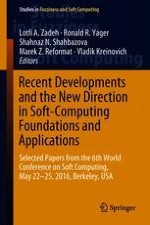This book is an authoritative collection of contributions in the field of soft-computing. Based on selected works presented at the 6th World Conference on Soft Computing, held on May 22-25, 2016, in Berkeley, USA, it describes new theoretical advances, as well as cutting-edge methods and applications. Theories cover a wealth of topics, such as fuzzy logic, cognitive modeling, Bayesian and probabilistic methods, multi-criteria decision making, utility theory, approximate reasoning, human-centric computing and many others. Applications concerns a number of fields, such as internet and semantic web, social networks and trust, control and robotics, computer vision, medicine and bioinformatics, as well as finance, security and e-Commerce, among others. Dedicated to the 50th Anniversary of Fuzzy Logic and to the 95th Birthday Anniversary of Lotfi A. Zadeh, the book not only offers a timely view on the field, yet it also discusses thought-provoking developments and challenges, thus fostering new research directions in the diverse areas of soft computing.
